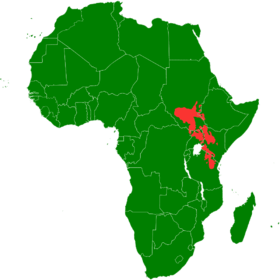Nilotische talen
De Nilotische talen is de grootste taalgroep binnen de Oost-Soedanese talen, die weer tot de Nilo-Saharaanse talen behoren.

De talen en dialecten binnen deze taalgroep worden in een gebied gesproken dat zich uitstrekt van het zuiden van het land Soedan tot in Tanzania. De sprekers van de Nilotische talen worden de Nilotische volkeren genoemd. Deze volkeren zijn traditioneel gezien in hoofdzaak veehouders.
Classificatie en talen
De Nilotische talen worden in de volgende drie subgroepen onderverdeeld:
Hieronder volgt een lijst van talen, gegroepeerd op hun verdere classificatie.[1]
Oost-Nilotische talen
West-Nilotische talen
- Dinka-Nuer
- Dinka
- Nuer
- Reel of Atuot
- Nuer
- Luo
- Noordelijk
- Anuak
- Bor
- Belanda Bor
- Jur
- Luwo
- Mabaan-Burun
- Burun
- Mabaan
- Pari
- Shilluk
- Thuri
- Zuidelijk
- Dhopadhola of Adhola
- Kuman
- Luo-Acholi
- Alur-Acholi
- Alur
- Lango-Acholi
- Acholi
- Lango
- Luo
- Alur-Acholi
- Noordelijk
Zuid-Nilotische talen
- Kalenjin
- Elgon
- Kupsabiny
- Sabaot
- Nandi-Markweta
- Markweta
- Endo
- Talai
- Nandi
- Aramanik
- Kalenjin
- Kisankasa
- Mediak
- Mosiro
- Tugen
- Markweta
- Okiek
- Pökoot of Pokot
- Elgon
- Tatoga of Omotik-Datooga
- Omotik
- Datooga
| Bronnen |
This article is issued from
Wikipedia.
The text is licensed under Creative
Commons - Attribution - Sharealike.
Additional terms may apply for the media files.